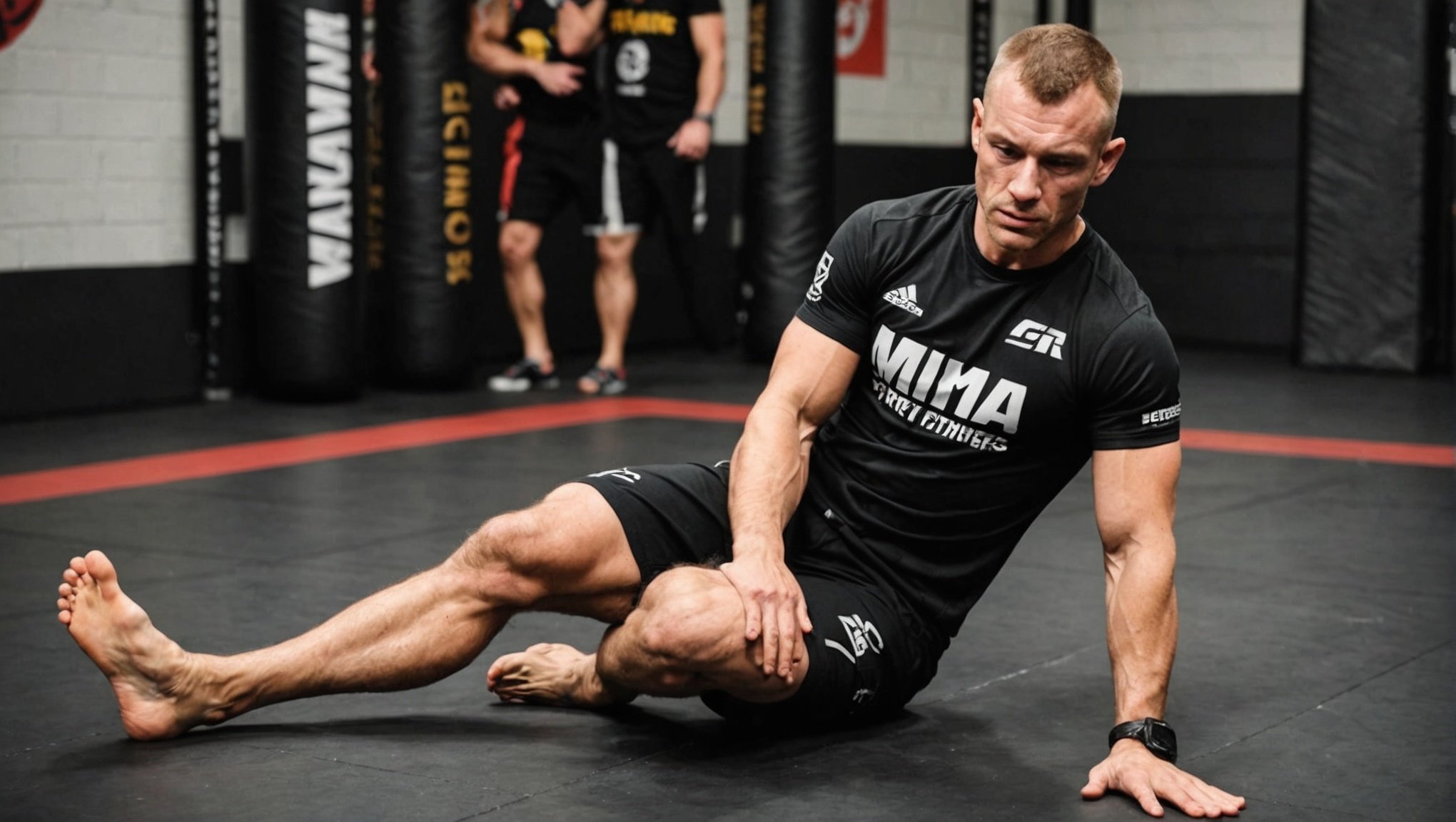Importance of Stretching in MMA
Stretching plays a crucial role in enhancing performance in Mixed Martial Arts (MMA). It prepares fighters for the demanding flexibility and agility required in the sport. Proper stretching routines improve flexibility, which is vital for executing movements with precision and speed.
Flexibility and injury prevention are intrinsically linked. Stretching helps maintain muscle elasticity and joint mobility, reducing the risk of common injuries. By improving flexibility, fighters can prevent strains, sprains, and muscle tears, ensuring they remain at peak performance levels longer.
This might interest you : Master Your Footwork: The 5 Essential Drills Every UK Boxing Club Should Practice
Common injuries in MMA, such as hamstring pulls, shoulder dislocations, and ankle sprains, can be mitigated through regular stretching. By focusing on dynamic stretches during warm-ups and static stretches during cooldowns, fighters can enhance their range of motion and minimize injury risks.
Incorporating stretching benefits into an MMA training regimen is not only about boosting performance but also about promoting long-term health. Fighters who commit to comprehensive stretching routines often experience quicker recovery times, allowing them to train more effectively and reduce downtime due to injury.
Topic to read : Unlocking Mental Edge: The Impact of Sports Psychology on UK Fighters” Training
Essential Stretching Techniques for MMA Fighters
In mixed martial arts, incorporating effective stretching techniques into the training routine is pivotal for enhancing flexibility and preventing injuries. A balance of both dynamic stretching and static stretching ensures fighters can optimize their performance and maintain body health.
Dynamic Stretching Routine
Dynamic stretching is essential for warming up before a workout or fight. Unlike static stretches, these involve movement, improving blood flow and muscle readiness. Techniques like leg swings, arm circles, and spinal rotations are excellent movement-based stretches for MMA practitioners. Such stretches prepare the body by mimicking movements used in training, thereby reducing the risk of injury. Fighters should aim to integrate dynamic stretches into all training sessions to enhance overall agility and coordination.
Static Stretching Routine
Post-training, static stretching techniques are vital to aid muscle recovery and maintain flexibility. Holding stretches like hamstring bends and quadriceps holds are beneficial for muscle groups heavily engaged in MMA. These stretches should be performed slowly, holding each position for at least 20-30 seconds. Regular practice after training sessions improves muscle elasticity, which helps maintain a fighter’s longevity in the sport.
Expert Insights and Testimonials
Understanding the insights of MMA coaches and fighters can offer profound expertise regarding stretching in training regimens. Many UK MMA fighters emphasise that incorporating a stretching routine has dramatically influenced their performance and recovery. Consistent stretching, they attest, has not only enhanced their flexibility but also reduced the risk of injury, allowing them to extend their careers.
Coaches often advocate for a personalized stretching plan, tailored to the fighter’s unique body mechanics and fight style. This strategy allows fighters to target areas requiring specific attention, effectively optimizing their training outcomes.
One MMA coach articulates, “Stretching should be as planned and purposeful as sparring,” highlighting its crucial role. To illustrate the success of these tailored stretching routines, several fighters share testimonials about improvements in mobility and agility. For instance, a prominent fighter credits a structured stretching routine as key to recovering quicker and enhancing their competitive edge. Such real-life stories underscore the positive impact of consistent stretching in martial arts.
Overall, the collective testimonials and opinions from industry professionals demonstrate a considerable consensus on the benefits of integrating stretching into MMA training programs.
Frequency and Timing of Stretching
Understanding stretching frequency within your pre-training routine and post-training routine is crucial for maximizing performance and recovery.
Pre-Training Stretching Guidelines
Before diving into any workout, it’s recommended to incorporate dynamic stretches into your pre-training routine. This should be done consistently—ideally before every training session. Dynamic stretches, like leg swings or arm circles, are beneficial as they effectively warm up the body, enhancing blood flow and boosting flexibility. This not only prepares muscles for the demands of exercise but also reduces the risk of injury.
Post-Training Stretching Guidelines
After training, cooling down with static stretching is essential. Cooling down helps in muscle recovery and diminishes the likelihood of stiffness. Aim to stretch post-training every session, focusing on major muscle groups utilized during the workout. This consistent practice aids in injury prevention and accelerates recovery.
Adjusting Stretching Based on Training Intensity
Training intensity dictates the need for adaptation in your stretching regimen. On high-intensity days, consider incorporating more post-training routine stretches to facilitate recovery. Conversely, less intensive sessions might require minimal stretching adjustments. Recognizing your body’s signals is vital in deciding whether to increase or reduce your stretching activities.
Visual Aids and Video Resources
Visual resources can be immensely helpful for perfecting stretching techniques. Engaging with visual stretching guides provides learners with practical insights into the precise movements and forms required. By watching demonstrations, individuals can mimic the correct procedures, avoiding common mistakes.
A popular method to grasp these techniques is through MMA training videos. Such content often includes comprehensive guides to stretching, tailored for flexibility and injury prevention. These videos typically break down each movement, ensuring that even beginners can follow along easily. The advantage here is the step-by-step visual instruction, allowing you to see muscles in action.
Several reputable platforms offer high-quality content. Look for platforms that allow professionals to demonstrate stretching demonstrations, ensuring you are learning from reliable sources. These demonstrations showcase techniques used by athletes to maximise performance and reduce injury risk.
Remember, the key is consistency and practice. Using these resources, you can develop a routine that aids not just in training but contributes to overall physical well-being. So, explore these visual stretching guides and MMA training videos to enhance your flexibility and form today.






